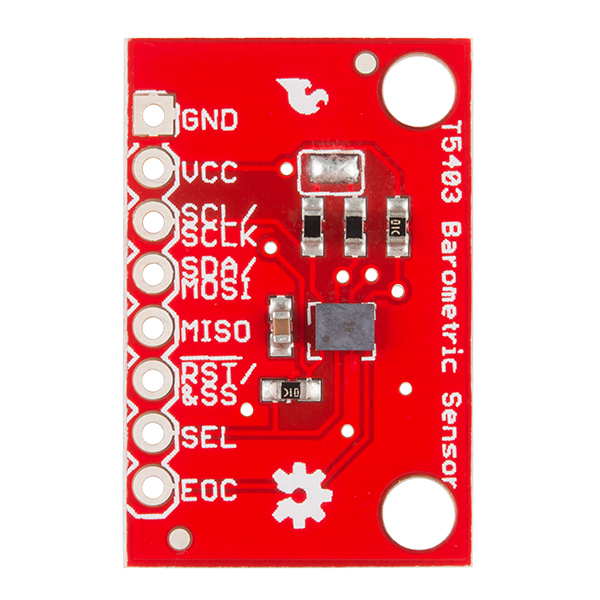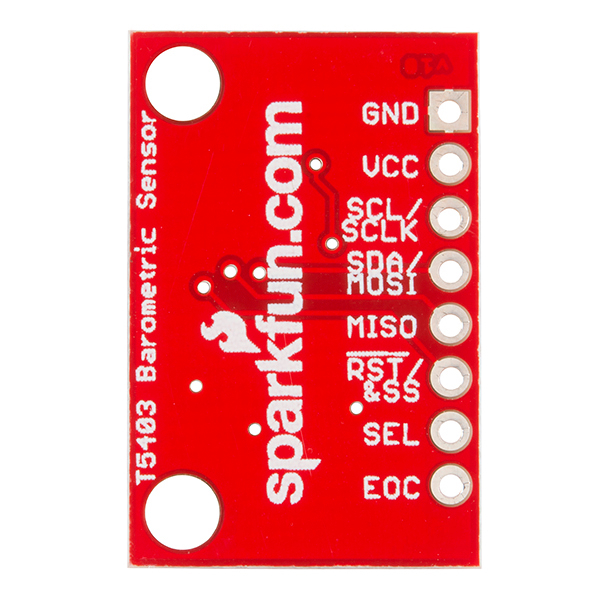SparkFun Barometric Sensor Breakout - T5403
This is the T5403 breakout board, a fully calibrated barometric pressure sensor with an I2C interface. The T5403 sensor measures the absolute pressure of the air around. This pressure varies with both the weather and altitude. Depending on how you interpret the data, you can monitor changes in the weather, measure altitude, or any other tasks that require an accurate pressure reading.
The T5403 sensor consists of a piezoresistive MEMS pressure sensor element and an ASIC (application specific integrated circuit) with integrated temperature sensor, analog to digital converter ADC, memory and digital circuitry. Each breakout requires a supply voltage of 1.7V to 3.6V with a low current consumption of 790µA max and each pin (GND, VCC, SCL/SCLK, SDA/MOSI, MISO, RST/&SS, SEL, and EOC) broken out.
- Supply Voltage: 1.7-3.6V
- Max Current Consumption: 790µA
- Pressure Range: 300hPa - 1100hPa
- I2C Interface
- 16 bit ADC
- Internal Oscillator
- Schematic
- Eagle Files
- Datasheet
- Hookup Guide
- GitHub (Design Files & Example Code)
- GitHub (Library)
- Product Video
SparkFun Barometric Sensor Breakout - T5403 Product Help and Resources
T5403 Barometric Pressure Sensor Hookup Guide
March 6, 2014
T5403 Barometric Pressure Sensor Hookup Guide
I2C Address
The I2C address is 0x77, which is defined in the Arduino code and is fixed.
Core Skill: Soldering
This skill defines how difficult the soldering is on a particular product. It might be a couple simple solder joints, or require special reflow tools.
Skill Level: Noob - Some basic soldering is required, but it is limited to a just a few pins, basic through-hole soldering, and couple (if any) polarized components. A basic soldering iron is all you should need.
See all skill levels
Core Skill: Programming
If a board needs code or communicates somehow, you're going to need to know how to program or interface with it. The programming skill is all about communication and code.
Skill Level: Competent - The toolchain for programming is a bit more complex and will examples may not be explicitly provided for you. You will be required to have a fundamental knowledge of programming and be required to provide your own code. You may need to modify existing libraries or code to work with your specific hardware. Sensor and hardware interfaces will be SPI or I2C.
See all skill levels
Core Skill: Electrical Prototyping
If it requires power, you need to know how much, what all the pins do, and how to hook it up. You may need to reference datasheets, schematics, and know the ins and outs of electronics.
Skill Level: Competent - You will be required to reference a datasheet or schematic to know how to use a component. Your knowledge of a datasheet will only require basic features like power requirements, pinouts, or communications type. Also, you may need a power supply that?s greater than 12V or more than 1A worth of current.
See all skill levels
Comments
Looking for answers to technical questions?
We welcome your comments and suggestions below. However, if you are looking for solutions to technical questions please see our Technical Assistance page.
Customer Reviews
4 out of 5
Based on 1 ratings:
1 of 1 found this helpful:
Good addition to my weather station
I am using this with two DS18B20 temp sensors and a MicroView as a weather station. MicroView shows indoor/outdoor temp and pressure. Added my Raspberry pi to catch the serial data from the MircoView and have it uploading to Weather Underground. I also have an Ambient Weather WS-1400-IP station I got as a birthday gift that uploads to WU. I have been comparing the temps and pressure plots between the two stations and the measurements are pretty close to the same. I did have to add a correction factor to get this one to match the pressure reading of the WS-1400-IP... using the example code with my altitude (8500 ft.) didn't seem to get it quite right. Next step is adding the Si7021 humidity sensor which might be tomorrow's task. Will review that one once I see how the plots compare.





NOTE: SPI not supported. The datasheet T5400.pdf says: "I2C and SPI interface", but the comment of the code in the Github (Design Files) says: "NOTE: SPI is currently unsupported in the hardware." I would find it helpful if the product description page were annotated when you are aware that the datasheet is wrong.
NOTE: Only one T5403 per I2C bus, since the slave address is fixed at 0x77.
I wrote a Python script for T5403 + RaspberryPi . I cloned it from the Arduino example on Github. Please take it from here
I used your example in my early workings with the T5403. One thing that helped though was to convert it to a class to be used with other sensors on the I2C bus. Thanks for putting that effort in!
I am using a picaxe micro-controller to get barometric pressure from the T5400. I have used I2C for other devices. I just changed slave addr to 0x77, but it didn't seem to help. I input 2 bytes, but first byte receives all ones, and 2nd byte all zeros.Any ideas?
Update on my post. I found the data sheet for T5403 with all the addresses of the REGISTERS. Now I'm wondering if I can't get RAW pressure reading because I have not filled in CALIBRATION registers.
Has anyone had any experience with using any of these bp sensors outdoors? I have to record bp and other environmental variables outside and my last sensor (MPL115A2 from Adafruit), corroded within 1-2 months even though they were very protected from rain and dew. I'm looking for a better version that is compatible with outdoor use.
Does anybody know the difference between this T5403 and the BMP180? I know the BMP180 also measures temperature, but I'd like to know if there is so much difference between the energy each one of them uses and then conclude if this is worth it. Thanks & Regards!
Originally it was supposed to be a SPI enabled sensor. But as it stands the minor difference is this sensor reports in Pa directly as opposed to hPA like the BMP180. But that is just a difference in multiplying/dividing by 100. There is a size difference in the IC (T5403 is smaller) but that doesn't help much when it's attached to a breakout.